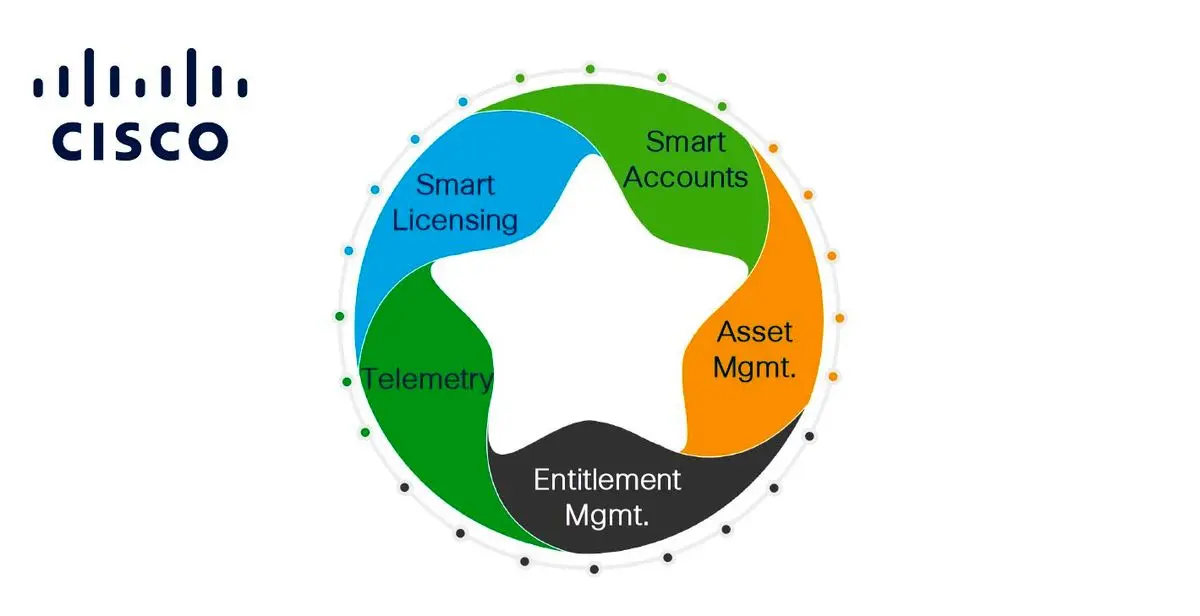Cisco License

Cisco Smart License simplifies managing licenses across organizations in different ways. While, Cisco classic licenses used to offer an imperfect view, as there was no way to keep track of all of the software licenses that they own and each device had to be registered manually using a PAK (Product activation keys), Smart Licenses are not node-locked to hardware anymore. So customers can easily pool license entitlements and change them around freely when needed. After that Smart Licensing establishes a pool of software licenses and no Product Activation Keys (PAKs) are needed for registrations. Moreover, by Leaving inconsistent licensing entitlements and management behind, Cisco is standardizing Smart Licensing across all products.
Generally, Smart license is cloud-based solution allows customers to automate time-consuming licensing tasks. The solution lets customers to simply check the status of your license and software usage trends. Smart Licensing helps simplify three core functions.
Cisco Smart License Benefits
First of all, Purchasing the software that you have installed in your network can automatically self-register themselves, without PAKs, Secondly, admin can automatically track activations against license entitlements. Also, there is no need to install the license file on every node. You can create license pools (logical grouping of licenses) to reflect your organization structure.
Smart Licensing offers a centralized portal (Cisco Software Service Management) that empowers management of all Cisco software licenses from one centralized website. The final advantage is reporting, through the portal, Smart Licensing offers an integrated view of all the licenses you have purchased and what has been deployed in your network. This data can be used to make better purchase decisions, based on environment.
Cisco Smart Account
Essentially, A Cisco Smart Account provides a repository for Smart enabled devices to be managed by their smart licenses. It lets you to manage and activate your product licenses, monitor licenses in use, and track Cisco license purchases. With transparent access, you have a real-time view into your smart licensing support products. IT admin can handle licenses and account of users within your organization’s Smart Account through the Smart Software Manager.
Cisco Virtual Account
Virtual accounts are groups of licenses and product instances which can be created in Smart Software Manager to manage the licenses for each company into logical entities. virtual accounts could be used to handle licenses by business unit, product type, IT group, or whatever makes sense for your organization.
For example, if you separate your company into different geographic regions, you can create a virtual account for each region to hold the licenses and product instances for that region.
Cisco License Reservation
Cisco Specific License Reservation (SLR) and Permanent License Reservation (PLR) allows customers in highly secure networks to use Smart Licensing (and Smart licenses) without communicating the license information. Cisco SLR License allows you to install a node-locked license file (SLR authorization code) on a product instance. This license file enables individual (specific) licenses (entitlement tags).
Cisco Smart License Using Policy
Prior to IOS XE 17.3.2, The IOS XE product used to boot in evaluation-mode, per product software and registration, and on-going communication every 30 days with the Cisco cloud was required.

While now, with Smart Licensing using Policy, the Device has all Licenses IN USE right out of the box. Plus, the earlier concepts, Evaluation mode, Registration, and Reservation is eliminated.
As a new deployment method for Smart Licensing, Cisco has introduced Smart License Using Policy following the IOS XE Amsterdam 17.3.2 and later. This new version supports following Cisco products: Cisco Catalyst 9000 series switches, routing platforms such as the ASR1K, ISR1K, ISR4K, Cisco Catalyst 9800 Series Wireless Controllers, IOT routers and switches, ACI, NX-OS, MDS and a few Collab products (CME, SRST, CUBE).
With this method, no evaluation mode is available at product boot and registration to cisco.com is not required anymore. Instead, customers should report them in use licenses either by using an automated reporting tool, API reporting, or direct connection from a product using a trusted connection to CSSM, or they can manually upload software use records (RUM reports) directly to CSSM via the Upload Usage Data button under the Reporting and Usage Data Files tabs. Moreover, there is a CSLU – Cisco Smart Licensing Utility that comes with Smart Licensing using Policy as a Smart Licenses Manager.
Cisco Smart Licensing Utility (CSLU)
Cisco Smart Licensing Utility (CSLU) is a lightweight windows application that is used to pull software use data from Cisco device and report the software use to CSSM. CSLU can be used to:
- Collect license usage reports from product instances.
- Store and forward usage reports to CSSM for billing and analytics.
- Obtain policy and authorization code from CSSM.
- Distribute policy and authorization to product instances.
Cisco DNA License Subscriptions
A Cisco DNA license is required for each router, switch, and wireless access point in order to enable its SDN features. Cisco DNA subscription are available in three tiers, each with its own set of features. These licenses exist in Essential, Advantage and Premier models.

license enables more features such as; Advanced automation, Lifecycle image management, AI/ML analytics and assurance and API/SDK integration.
Finally, with Cisco DNA center Premier License Encrypted Traffic Analytics and Multi-domain policy segmentation would be added. These licenses make it possible to manage and control licenses from a centralized platform
